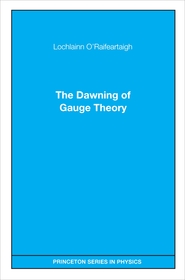
The Dawning of Gauge Theory
Sorozatcím: Princeton Series in Physics; 106;
-
10% KEDVEZMÉNY?
- A kedvezmény csak az 'Értesítés a kedvenc témákról' hírlevelünk címzettjeinek rendeléseire érvényes.
- Kiadói listaár GBP 95.00
-
45 386 Ft (43 225 Ft + 5% áfa)
Az ár azért becsült, mert a rendelés pillanatában nem lehet pontosan tudni, hogy a beérkezéskor milyen lesz a forint árfolyama az adott termék eredeti devizájához képest. Ha a forint romlana, kissé többet, ha javulna, kissé kevesebbet kell majd fizetnie.
- Kedvezmény(ek) 10% (cc. 4 539 Ft off)
- Kedvezményes ár 40 848 Ft (38 903 Ft + 5% áfa)
Iratkozzon fel most és részesüljön kedvezőbb árainkból!
Feliratkozom
45 386 Ft

Beszerezhetőség
Becsült beszerzési idő: A Prosperónál jelenleg nincsen raktáron, de a kiadónál igen. Beszerzés kb. 3-5 hét..
A Prosperónál jelenleg nincsen raktáron.
Why don't you give exact delivery time?
A beszerzés időigényét az eddigi tapasztalatokra alapozva adjuk meg. Azért becsült, mert a terméket külföldről hozzuk be, így a kiadó kiszolgálásának pillanatnyi gyorsaságától is függ. A megadottnál gyorsabb és lassabb szállítás is elképzelhető, de mindent megteszünk, hogy Ön a lehető leghamarabb jusson hozzá a termékhez.
A termék adatai:
- Kiadó Princeton University Press
- Megjelenés dátuma 1997. június 18.
- Kötetek száma Print PDF
- ISBN 9780691029771
- Kötéstípus Puhakötés
- Terjedelem272 oldal
- Méret 228x152 mm
- Súly 368 g
- Nyelv angol
- Illusztrációk 2 line illus. 100
Kategóriák
Hosszú leírás:
During the course of this century, gauge invariance has slowly emerged from being an incidental symmetry of electromagnetism to being a fundamental geometrical principle underlying the four known fundamental physical interactions. The development has been in two stages. In the first stage (1916-1956) the geometrical significance of gauge-invariance gradually came to be appreciated and the original abelian gauge-invariance of electromagnetism was generalized to non-abelian gauge invariance. In the second stage (1960-1975) it was found that, contrary to first appearances, the non-abelian gauge-theories provided exactly the framework that was needed to describe the nuclear interactions (both weak and strong) and thus provided a universal framework for describing all known fundamental interactions. In this work, Lochlainn O'Raifeartaigh describes the former phase.
O'Raifeartaigh first illustrates how gravitational theory and quantum mechanics played crucial roles in the reassessment of gauge theory as a geometric principle and as a framework for describing both electromagnetism and gravitation. He then describes how the abelian electromagnetic gauge-theory was generalized to its present non-abelian form. The development is illustrated by including a selection of relevant articles, many of them appearing here for the first time in English, notably by Weyl, Schrodinger, Klein, and London in the pre-war years, and by Pauli, Shaw, Yang-Mills, and Utiyama after the war. The articles illustrate that the reassessment of gauge-theory, due in a large measure to Weyl, constituted a major philosophical as well as technical advance.
"The book thus performs a double service: it offers a rewarding description of the development of the gauge symmetry idea that
is complete even without the original papers, and it makes those original papers readily accessible to physicists and mathematicians. . . . This book represents an important contribution to the history of fundamental ideas in physics." Több




